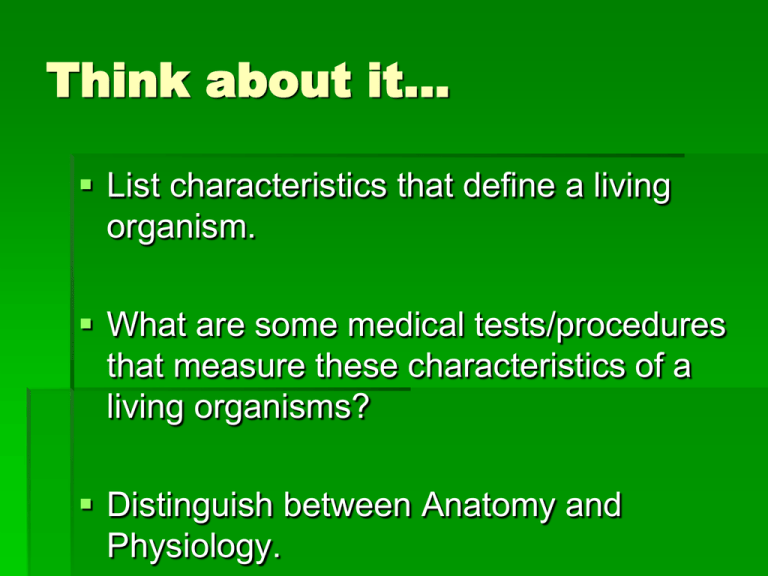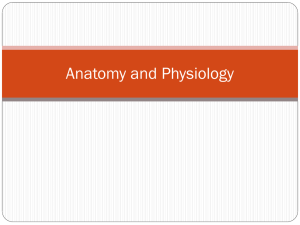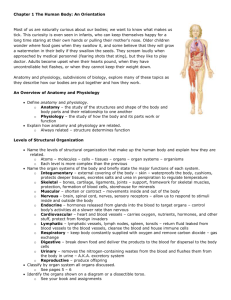Introduction history chara of life homeostasis
advertisement

Think about it… List characteristics that define a living organism. What are some medical tests/procedures that measure these characteristics of a living organisms? Distinguish between Anatomy and Physiology. Introduction to Anatomy and Physiology History Characteristics of Life Maintenance of Life Homeostasis Levels of Organization Organ systems What is the distinguishing factor between Anatomy and Physiology? Anatomy: morphology of Structures Forms and arrangements Physiology: Describes function of Structures What body parts do and how they do it. Ex: 1. Heart… 2. stomach… 3. mandible… History When did the study of the Body Begin? 384 B.C. Aristotle: first teacher of Anatomy 400 B.C. Hippocrates wrote many books: Described muscular-skeletal structure attempted to describe surgical procedures. Speculation NOT experimentation Greek physicians spoke of 4 humors (blood, phlegm, yellow bile and black bile) 100 AD Galen: Roman Anatomist Specialized in Gladiator fights Performed dissections as sideline entertainment Little understanding of physiology Books were destroyed by Church (library at Alexadria during fall of Roman empire) 1600’s Leeuwenhook: first observed and described microbes How was this observation important? Microbes cause disease Anatomy Act: 1832 United Kingdom Act of parliament expanded the legal supply of cadavers for medical research and education, in reaction to public fear and revulsion of the illegal trade in corpses. 1850’s Louis Pasteur Microbes cause disease Pasteurization of Milk Rabies Vaccinations 1876 Robert Koch Defined ID procedure for pathogens What events contributed to rapid discoveries in medicine after 1600’s? Other Major Advancements Karyotypes Chemo therapy/ Marie Curie: Radiation Laser Procedure Laughing Gas: Humphrey Davy: 1880 Soft Contact Lenses: 1971 Human Genome: 1990 Dolly: The Cloned Sheep 1996 Characteristics of Life Movement Responsiveness Growth Reproduction Respiration Metabolism (digestion/ Assimilation ) Absorption Circulation Excretion Requirements of Life Water - required for metabolism, transport, regulation Food - substances that provide nutrients Oxygen - used in the release of energy Heat - a form of energy which helps control metabolic reactions Pressure - application of force on an object Homeostatic Mechanisms work to control physiological maintenance. Homeostatic mechanisms: function to maintain stable environment Examples pH Oxygen levels Blood pressure Temperature glucose Homeostasis: Feedback mechanisms Negative Feedback: Receives a signal in environment and then causes a response that reverses the change Ex: Furnace and Hormone secretion **Most feedback mechanisms are Negative Positive Feedback: Initial signal produces a response that exaggerates the stimulus Example: milk production and blood clotting Homeostasis in Medicine Homeostasis mechanisms maintain a relatively constant internal environment, but physiological values vary in an individual. Normal values for an individual and the idea of a normal range for the population are clinically important. Structural Levels of Organization What is the Smallest unit of all matter? 1. 2. 3. 4. 5. 6. 7. 8. 9. Cells Organs Tissues Macromolecules Atoms Molecule Organ system organism organelles Organ Systems Integumentary Skeletal Muscular Nervous Endocrine Cardiovascular Lymphatic Digestive Respiratory Urinary Reproductive Integumentary System Skin, hair, sweat glands, sebaceous glands Protects underlying tissues Site of sensory receptors Regulates body temperature Synthesis of biochemicals Skeletal System Bones, ligaments, cartilage, joints Body framework Protection of vital organs Attachment for muscles Blood cell production Storage of inorganic salts Muscular System Muscles Body movement Body posture Generation of body heat Nervous System Brain, spinal cord, nerves, sense organs Detect changes in the internal and external environment Receive and interpret sensory information Stimulate muscles and glands Endocrine System Glands that secrete hormones Pituitary thyroid, parathyroid, adrenal, ovaries, testis and pancreas Hormones alter metabolism in target cells Transport Systems Cardiovascular system heart, arteries, capillaries, veins, blood Pumps blood thru vessels and transport of gases, nutrients, hormones, wastes Lymphatic system lymphatic vessels, fluid, nodes, thymus, spleen, lymphocytes Protect against infection and disease Digestive System Mouth, tongue, teeth, salivary glands, pharynx, esophagus, stomach, liver, gallbladder, pancreas, small and large intestine Ingestion of food Breakdown of food molecules Absorption of nutrients http://kidshealth.org/misc/movie/bodybasics/digestive_system.html Respiratory System Nasal cavity, pharynx, larynx, trachea, bronchi, lungs Movement and exchange of respiratory gases, oxygen and carbon dioxide between air and blood Urinary System Kidneys, ureters, urinary bladder, urethra Remove wastes from blood Maintain body water and electrolyte balance Transport urine Reproductive System Male: scrotum, testes, epididymides, vasa deferentia, seminal vesicles, prostate gland, bulbourethral glands, urethra, penis Female: ovaries, uterine tubes, uterus, vagina, clitoris, vulva Reproductive System Produces gametes, support development of embryo Organ System Review What Organ system is responsible for production of body heat? What organ (s) are found in the Skeletal System? What is the Function of the Lymphatic System? A doctor records high blood pressure (150/95) in a patient’s chart. Which system should this doctor evaluate more extensively? Provide an example of how organ systems can be integrated? (in other words, how do some systems share the same function?) Lifespan Changes Aging is the passage of time and accompanying bodily changes, from the wholebody level to the microscopic level.





